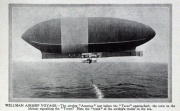Walter Wellman
Walter Wellman (1858-1934) was a life-long journalist and Washington correspondent for a major Chicago newspaper, but his abiding passion was exploration. During his Washington years, he carried out five expeditions toward the North Pole (three of them by airship); an expedition to Watling Island (San Salvador) in the Bahamas to locate the first landfall of Columbus; and, in 1910, an aborted airship flight across the Atlantic Ocean.
Walter Wellman was born in Mentor, Ohio, in 1858, and died in New York City of liver cancer in 1934. His book about his polar expeditions was published in 1911 as The Aerial Age. Other significant articles on polar subjects authored by Wellman include “Where is Andrée?” (1898); “Sledging Toward the Pole” (1900); “An Arctic day and night” (1900); “The polar airship” (1906); “By Airship to the North Pole” (1907); and “Will the “America” Fly to the Pole?” (1907).
In 1893, at age thirty-five, Wellman journeyed to Norway in search of knowledge of ice conditions around Spitsbergen (in Svalbard) and, in the process, a short cut to the North Pole. In the spring of 1894, Wellman sailed for Spitsbergen on a Norwegian ice-steamer called Ragnvald Jarl, eventually pitching camp in early May at British sportsman Arnold Pike’s House on the shores of Virgo Harbor (Norwegian: Virgohamna), a locale soon to figure so prominently in the history of polar aviation. On 10 May, Wellman sailed north and east on the Jarl and arrived at the Seven Islands forty-eight hours later, an extremely fast passage. At the Seven Islands, Wellman’s luck ran out. After leaving the Ragnvald Jarl and taking to sledges and aluminum boats, Wellman’s party scarcely progressed north at all when a courier overtook them and reported that ice had holed the Jarl along the western shore of tiny Walden Island.
This experience led Wellman to his first consideration of the use of some method of aerial exploration in the Arctic.
In 1898 Wellman chartered the steamer Frithjof and sailed to Franz Josef Land with three other Americans, Evelyn Briggs Baldwin, Quirof Harlan, and Edward Hofma, and five Norwegians, Paul Bjørvig, Bernt Bentzen, Daniel Johansen, Emil Ellefsen, and Olaf Ellefsen. Since Wellman on this expedition used no aeronautical apparatus, his aerial ambitions were confined to a brief and ultimately futile search for the missing Swedish balloonist S.A. Andrée and his crew. Wellman’s "dash" for the pole itself in the spring of 1899 failed off the east coast of Rudolf Island. Wellman then sent Baldwin to the north and east where Baldwin around Wilczek Island where, the previous fall, Baldwin had thought he had seen new features.
Baldwin's brief sledge expedition would lead to the only significant geographic discoveries of the expedition, as Baldwin and the Norwegians Daniel Johansen, Emil Ellefsen, Olaf Ellefsen, and Paul Bjørvig located a large island Wellman later named for Alexander Graham Bell. The northern cape of this island Baldwin named Cape Elias Baldwin after his father. Baldwin’s field notes from this spring sledge expedition reveal the first glimpses of Graham Bell Island, the easternmost island in the Franz Josef Land archipelago (see Capelotti 2006).
On 1905-12-31, Wellman announced he would make an attempt to reach the North Pole, but this time with an airship. His newspaper provided funds of USD 250,000, and he had an airship built in Paris. At Virgo Harbor in Spitsbergen, a large airship hangar and expedition base camp was assembled. But the hangar was not completed until August and when tested the airship’s engines promptly self-destructed.
Wellman returned to Virgo Harbor in the summer of 1907 with an airship configured by Melvin Chester Vaniman, who had scrapped the original Louis Godard car and designed one of his own. He built the new car with steel tubing and steel-reinforced wood, 115 feet long and twelve feet wide at its open top. The car tapered inwards from the top, down to a narrow catwalk, underneath which a long steel 1,200-gallon fuel tank formed the keel. He wrapped the car in oiled silk to protect the crew from wind, and mounted more powerful propulsion. He selected a Lorraine-Dietrich 75 hp engine, driving two propellers mounted, not fore and aft, but side by side, on booms riding out from the sides of the car. August 1907 came and went, and still the airship remained tethered in her shed. The winds did not abate until early September, at which time Wellman ordered a short trial flight of fifteen miles. This was the first time a motorized airship had flown in the Arctic.
Wellman tried for the pole one last time, in the summer of 1909. About sixty miles north of the hangar at Virgo Harbor, the trailing ballast line that Wellman called an "equilabrator," fell off. The disaster caused Wellman to turn the airship around and receive a rescue tow from a nearby Norwegian survey ship, the Farm.
In the fall of 1910, Wellman built a new dirigible. With this new dirigible, Wellman flew in a huge arc past Cape Cod and then southeast for over 1,000 miles — a far greater distance than that from Virgo Harbor to the Pole—before engine trouble forced the journalist and his crew to abandon ship not far from Bermuda. Wellman brought the ship down within a mile of a passing steamer, which delivered Wellman and his crew to shore. This Atlantic adventure set a record for the longest airship flight to that moment in aviation history.
After the failure of the Atlantic flight in 1910, Wellman lived on until 1934, but he never got into another airship.




